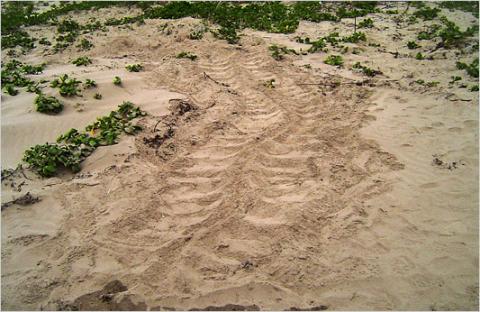A fully grown female leatherback sea turtle is a truly large animal. When she nests for the first time at about 10-15 years of age, she’ll probably be six to eight feet long. She'll weigh 1,200 to 1,500 pounds, which is a good bit more than any other kind of sea turtle -- or your average bull moose, for that matter.
Stand up and stretch your arms straight out to the side. Unless you are at least six feet tall, the full span of your reach, fingertip to fingertip, will not be as wide as the tracks that old girl makes in the sand when she crawls up the beach to lay her eggs.
Tracks of that size (actually more than six feet wide) and some exposed eggs are what staffers at Padre Island National Seashore came across while patrolling the beach on June 6. Federal biologists who examined the tracks and eggs confirmed that a leatherback had nested on a Texas beach for the first time since the 1930s.
The leatherback sea turtle is a federally protected endangered species. Its worldwide population has been shrinking for the past several decades due to nesting habitat loss, poaching (nest robbing), marine debris ingestion, boat collisions (especially propeller wounds), commercial fishing, and other factors. It's thought that there may be fewer than 25,000 breeding age female leatherbacks left in the whole world. That's about one-seventh the number tallied in 1980.
Imagine the excitement that the Padre Island nesting generated at The Leatherback Trust, an NGO established to help save the leatherback sea turtle from extinction.
Leatherbacks are known to nest at only a few places in U.S. territory. About three dozen nest on the Atlantic coast of Florida each year. Slightly larger numbers nest in Puerto Rico and the U.S. Virgin Islands, and a few may nest in North Carolina.
Just why a leatherback happened to lumber ashore at Padre Island remains a mystery. Was this anomalous nesting simply a random event, maybe one of those exploratory things that dispersers do to check out new possibilities? Was it somehow related to global warming or shifts in ocean currents? Will other leatherbacks nest at Padre Island this year? Will coming years bring even more leatherback nestings at Padre Island? We’ll just have to wait while biologists, the turtles’ biological clock, and the passage of the years sort things out.
The old gal at the center of attention here will probably be in no hurry. If she’s a typical leatherback she won’t nest again for two or three years.


 Support Essential Coverage of Essential Places
Support Essential Coverage of Essential Places







Add comment